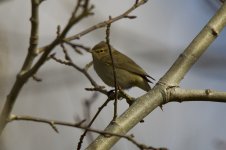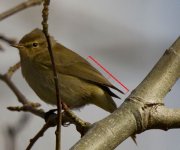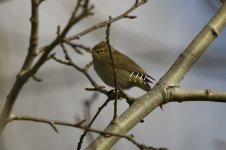-
Welcome to BirdForum, the internet's largest birding community with thousands of members from all over the world. The forums are dedicated to wild birds, birding, binoculars and equipment and all that goes with it.
Please register for an account to take part in the discussions in the forum, post your pictures in the gallery and more.
You are using an out of date browser. It may not display this or other websites correctly.
You should upgrade or use an alternative browser.
You should upgrade or use an alternative browser.
Rutland Water, UK (1 Viewer)
- Thread starter sthwild
- Start date
More options
Who Replied?Stuart Darbyshire
45th generation Northern
Yes, chiffchaff
Mark Lew1s
My real name is Mark Lewis
The primary projection can't be easily measured because you can't see the full extent of the tertials. With that weak super, strong eye ring and dark legs it looks like a chiffchaff to me.
KenM
Well-known member
The primary projection can't be easily measured because you can't see the full extent of the tertials. With that weak super, strong eye ring and dark legs it looks like a chiffchaff to me.
Follow the greater covert bar round, that's the approximate start of the tertials, it is clear where they end...even if you have a limited understanding of wing formula you can see that the pp is far too long for CC and is equal to the tertials.
Unfortunately some people can only see CC when confronted with a dark Legged Phyllosc. However the wing formula is clear and unequivocal in my opinion.
Cheers
Samuel Perfect
Well-known member
Is this where you mean the tertial base is Ken? I measured the primary to tertial ratio as 1:1.21. If anything, I should have placed the base of the tertials higher up in line with the greater cov bar which would make the ratio even more disproportionate.
I can't be sure but is the 6th P emarginated just before the shadow covers the primaries?
I can't be sure but is the 6th P emarginated just before the shadow covers the primaries?
Attachments
Mark Lew1s
My real name is Mark Lewis
KenM
Well-known member
Is this where you mean the tertial base is Ken? I measured the primary to tertial ratio as 1:1.21. If anything, I should have placed the base of the tertials higher up in line with the greater cov bar which would make the ratio even more disproportionate.
I can't be sure but is the 6th P emarginated just before the shadow covers the primaries?
I'm placing the top tertial in alignment with the greater covert bar, and following the shadow/break alignment on the last tertial...as the end of!
I'm only seeing emarginations on two, three and four, with an ''apparent'' emargination on ''5th'' being a shadow line.
Wherever..one ''ends the tertials'' in my opinion the pp is still too long.
Cheers
LowellMills
Is this your Sanderling?
If it must be anything, it's a Chiffchaff, based on the limited evidence if you must.
In honesty, if you can't see the primary projection and 6th emargination clearly, and you can't hear it, then it's willow-chiff and it has to stop there.
In honesty, if you can't see the primary projection and 6th emargination clearly, and you can't hear it, then it's willow-chiff and it has to stop there.
Mark Lew1s
My real name is Mark Lewis
If it must be anything, it's a Chiffchaff, based on the limited evidence if you must.
In honesty, if you can't see the primary projection and 6th emargination clearly, and you can't hear it, then it's willow-chiff and it has to stop there.
Normally, I'd fully endorse such a cautious standpoint - however, there is only one person saying that this bird shows willow warbler features - which has been disputed by others.
What it definitely does show is dark legs, and a prominent split eye ring - both strongly supporting chiffchaff (but not excluding WW of course). It also appears to show emarginations on P3, P4, P5, and P6. From the photo, it's impossible to say for sure that P6 is definitely emarginated, but it would be some coincidence if that shadow just happened to fall exactly where the emargination on a chiff would be. Have a look at the picture here (scroll down to 8th April):
http://www.portlandbirdobs.org.uk/latest_apr2009.htm
It's an almost identical pattern to how I marked the emarginations as I saw them earlier on in the thread.
What would the chances be of some sort of shadow falling exactly in the right place to create the false impression of an emargination, on a willow warbler that also has dark legs and a very chiffchaff like face pattern?
Mark Lew1s
My real name is Mark Lewis
Also, if you look at the portland photo linked above, look at where the tips of the tertials fall in relation to the emargination on P6 - just beyond the emargination. If you were to measure PP from that point on the OPs bird, you'd have a phyllosc with perfect PP for a chiffchaff.
KenM
Well-known member
Also, if you look at the portland photo linked above, look at where the tips of the tertials fall in relation to the emargination on P6 - just beyond the emargination. If you were to measure PP from that point on the OPs bird, you'd have a phyllosc with perfect PP for a chiffchaff.
I've looked at the Portland Phyllosc. comparative and am finding a pp-tertial ratio of 77% for WW and a very short 46% for Chiff Chaff on the ''In the hand'' sample birds...hardly a ringing endorsement for the OP's bird which I have found to be at worst...75% of overlying tertials. These comparisons (which can be seen and can be compared), unlike the 4th emargination which is not definitely present!
Regarding the cosmetics as you know! these are distinctly variable between the two species, split concentric eye-rings and darker legs, are not the monopoly of P.collybita, as I'm sure the ringers at Portland will attest.
Put simply...I'm seeing a Phyllosc. with ''longer'' rather than shorter wings, with no proven 4th emargination, If by magic another in the hand image of the same bird was provided, showing that elusive ''4th E'' I'd have to consider a greater degree of pp flexibility for the Chiff Chaff taxa.
Cheers
Mark Lew1s
My real name is Mark Lewis
I think you're the only one who has a problem with the primary projection Ken. Everyone else is seeing a bog standard chiffchaff.
Have you at least considerd that your assessment of the PP might be incorrect? We are looking at the bird from very slightly below - and as such we can't see the details of where the tertials start and end. If we can't do that we can't use PP as a feature.
Have you at least considerd that your assessment of the PP might be incorrect? We are looking at the bird from very slightly below - and as such we can't see the details of where the tertials start and end. If we can't do that we can't use PP as a feature.
SaxonBirder
Active member
It's nothing but a Chiffchaff.
Though I've heard worse from people who have had rare warbler records rejected.
Though I've heard worse from people who have had rare warbler records rejected.
sylvia staffs
Filthy tick hungary Twitcher
Bog standard Chiffchaff.
Similar threads
- Replies
- 3
- Views
- 678
Users who are viewing this thread
Total: 2 (members: 0, guests: 2)







